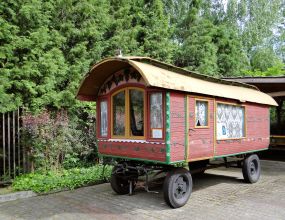 Source: Wikimedia Commons, by Jolanta Dyr (2013)
Source: Wikimedia Commons, by Jolanta Dyr (2013) Every people, from small to large, is capable of making a contribution to the public treasury of culture. One of these is Roma. Scattered all over the world, they have a long history and, like a sponge, absorb the customs and traditions of their place of residence. One of the interesting places where we can get to know Roma better is the Museum of Roma Culture and Life.
The Museum of Roma Culture and Life is located in the city of Kostroma, Russia. It was founded by the head of the Kostroma city public organization “Kostroma Association of Roma” and a great enthusiast of his business in 2015. It took him 9 years to assemble the collection for the permanent exhibition.
Presumably, the idea of organizing such a space came to the man due not only to great passion about Roma, but also to the fact that in all aspects on the pages of history, Roma most often go unnoticed. Thus, this place took upon itself to bring some clarity.
The museum is a space of several rooms, which has tried to incorporate all aspects of Roma’s life in Russia. The first room is dedicated to getting to know the people. At the entrance we are greeted by a map with the history of nomadic migration of Indian descendants and an old collection of photographs. In the recess there is an improvised tent, the walls of which are covered with multi-colored carpets in Oriental and Slavic styles and patterned scarves.
“Roma without a horse is like a bird without wings,” says the guide. Near the tent stands a life-size horse, symbolizing the deep connection of the people with this animal. Inside there are three mannequins with traditional theatrical costumes, which were sewn by Roma themselves: two for women and one for men. Women's style includes long colorful skirts, aprons, bright ruffled blouses, head scarves and massive neck jewelry. A men's costume consists of a loose patterned shirt, vest, wide leather belt and trousers. Among other things, in the tent you can also see two guitars as a symbol of the national musical instrument, and pottery, as some Roma families in Russia consider its making as their traditional craft.
The design of the museum hall is dedicated to one of the most difficult pages of history - the Second World War. A collection of newspaper clippings, photographs, letters, copies of documents and wartime archives tell the story of Roma's participation in the war as fighters and heroes, and about terrible genocide that Roma had to endure. The museum tour lifts the curtain on the dark pages of the people’s life, which in the case of Roma most often remain unpublicized.
The next space is everything connected with the Romen Theater (Romen is one of the only Roma theaters. It was founded in Moscow in 1931 and continues to be active to this day. Its performances tell the story of Roma through art). The history of the theater, its artists, founders and artistic directors, posters of performances and photographs in the words of the guide come together into an overall picture and take us into the colorful, fiery world of music, songs and dances.
The last part of the museum greets us with a hospitable space that imitates the life of Roma in Kostroma. In a large room with flowered wallpaper on the right side we can see a large canvas depicting Roma dancing in a long skirt, surrounded by people. Next to it stands a piano as an object of Roma great love to music. In the corner of the room there is a small chest of drawers, filled with Orthodox icons, since the Roma in this part of Russia are Christians. The room is full with a wide range of different color combinations: golden elements on the furniture, flowers, dark and pale colors mixed all together.
Among other things, the Mishto Yavyan puppet theater was also founded and located on the basis of this place. All performances are dedicated to Roma and their culture, and Roma themselves take part in the performances. In 2022, the theater took part in the interregional festival of Roma culture “Flame of the Heart” and was awarded a Grand Prix diploma in the category “Theater Art”.
However, the Museum is not only a journey through the cultural and everyday aspects of Roma life, but also a library. What makes it unique is its collection of fairy tales and stories written by Roma and about Roma; children's books, primers, Hungarian Roma magazines, everything is translated into Romani language.
Outside the walls of a culturally significant place, the founder of the museum also organizes concerts with a music and dance program.
Unfortunately, there are few places in the world that dispel the veil of stereotypes and prejudices about Roma, and this museum is one of the few that, with such diligence and great love, tells what no one else does.